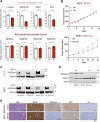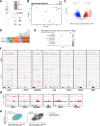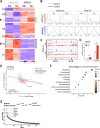Lineage-specific canonical and non-canonical activity of EZH2 in advanced prostate cancer subtypes
- PMID: 39117665
- PMCID: PMC11310309
- DOI: 10.1038/s41467-024-51156-5
Lineage-specific canonical and non-canonical activity of EZH2 in advanced prostate cancer subtypes
Abstract
Enhancer of zeste homolog 2 (EZH2) is a histone methyltransferase and emerging therapeutic target that is overexpressed in most castration-resistant prostate cancers and implicated as a driver of disease progression and resistance to hormonal therapies. Here we define the lineage-specific action and differential activity of EZH2 in both prostate adenocarcinoma and neuroendocrine prostate cancer (NEPC) subtypes of advanced prostate cancer to better understand the role of EZH2 in modulating differentiation, lineage plasticity, and to identify mediators of response and resistance to EZH2 inhibitor therapy. Mechanistically, EZH2 modulates bivalent genes that results in upregulation of NEPC-associated transcriptional drivers (e.g., ASCL1) and neuronal gene programs in NEPC, and leads to forward differentiation after targeting EZH2 in NEPC. Subtype-specific downstream effects of EZH2 inhibition on cell cycle genes support the potential rationale for co-targeting cyclin/CDK to overcome resistance to EZH2 inhibition.
© 2024. The Author(s).
Conflict of interest statement
H.B. has served as consultant/advisory board member for Janssen, Astra Zeneca, Merck, Pfizer, Amgen, Astellas, Sanofi Genzyme, Novartis, Bayer, Daiichi Sankyo, and has received research funding (to institution) from Janssen, Bristol Myers Squibb, Circle Pharma, Daiichi Sankyo, Novartis. L.P. is an employee at Loxo Oncology@Lilly, this work was completed prior to her employment at Loxo, she is acting on her own, and these endeavors are not in any manner affiliated with Loxo Oncology@Lilly. The remaining authors declare no competing interests.
Figures





Update of
-
Lineage-specific canonical and non-canonical activity of EZH2 in advanced prostate cancer subtypes.Res Sq [Preprint]. 2024 Mar 4:rs.3.rs-3935288. doi: 10.21203/rs.3.rs-3935288/v2. Res Sq. 2024. Update in: Nat Commun. 2024 Aug 8;15(1):6779. doi: 10.1038/s41467-024-51156-5. PMID: 38405800 Free PMC article. Updated. Preprint.
References
-
- Abida W. et al. Genomic correlates of clinical outcome in advanced prostate cancer. Proc. Natl Acad. Sci. USA. 10.1073/pnas.1902651116, https://www.ncbi.nlm.nih.gov/pubmed/31061129 (2019). - PMC - PubMed
-
- Beltran, H. et al. Molecular characterization of neuroendocrine prostate cancer and identification of new drug targets. Cancer Discov.1, 487–495 (2011). 10.1158/2159-8290.CD-11-0130 - DOI - PMC - PubMed
MeSH terms
Substances
Grants and funding
LinkOut - more resources
Full Text Sources
Medical
Molecular Biology Databases

